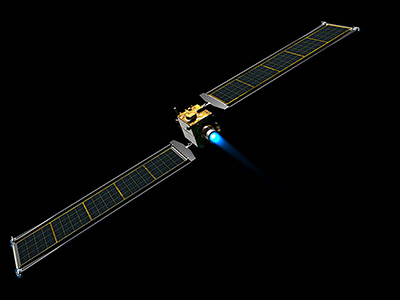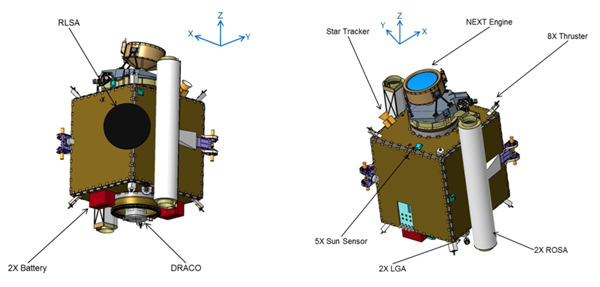Having long been an enabling partner for space voyages, and carefully cultivated a reputation for safety and reliability as well as performance, we’re now part of the first mission where a deliberate full-scale cosmic crash was the primary objective.
It’s not as crazy as it seems. NASA’s £240m Double Asteroid Redirection Test (DART) mission is part of the exciting international effort to explore ways in which we might in future defend ourselves from asteroids or comets on a collision course with Earth.

DART is designed to test the viability of the ‘kinetic impact’ technique. Think of it as an intergalactic game of billiards in which the DART space probe is the ‘cue’ and the 160-metre-wide asteroid moonlet Dimorphos is the ‘cue ball’: the probe will ‘tap’ Dimorphos at 15,000mph (6.6 km/s) to try to slightly alter its course.

Photo courtesy of NASA
We can measure the outcome because of Dimorphos’ binary relationship with the 780-metre asteroid Didymos. When Dimorphos passes in front of Didymos it briefly ‘dims’ some of its reflected light, which powerful Earthbound telescopes can detect. By monitoring the dimming frequency, scientists can calculate any post-collision change in Dimorphos’ orbit. Even a sub-1% deviation could prevent a future catastrophe for mankind.
But we’re still in the early learning stages of the concept – and this mission is as much a test of the technology used as of the technique.
The Challenge
Much of the equipment is already proven. The DART craft are deliberately designed using ‘off-the-shelf’ components in recognition that any response to an asteroid threat will have to be ‘swift’ – taking one-to-two years rather than the typical twenty-year space project timeline.
In such a scenario, equipment reliability will be mission critical.
The DART spacecraft is carrying the 1.2-metre Didymos Reconnaissance and Asteroid Camera for Optical navigation (DRACO) which will provide images of both asteroids and help the probe stay on its collision course during its final kamikaze charge. Images of the impact, crater and debris will be relayed via a cube satellite (LiciaCube) which the DART craft will launch 10 days prior to the crash.
The vital ‘control box’ for these activities is the Telemetry, Tracking and Command (TT&C) unit. Due to weight and power constraints, it has no redundancy, so mission success is riding on the reliable and precise performance of its sensitive antenna and its ability to transmit mission critical data.
The Solution
With so much riding on this single point of transmission, the TT&C’s design team decided to incorporate an isolator to help mitigate the risk. Acting like a one-way valve, it will buffer the antenna from unwanted electrical reflection and standing waves from the RF power source (TWTA) or accidental reflection of a transmitted signal – both of which could impede performance or cause mission failure.
Although adding to the highly constrained payload and consuming 2% of the system’s energy, it’s a worthwhile concession for the reassurance it will provide.
That’s where we come in. For such a high-profile mission, the design team wanted only the most trusted solution – and chose Smiths Interconnect’s WR112, X-Band high-power waveguide isolator. Just 30 millimeters wide and weighing well under the 1 kilogramme limit at 560 grammes, its superior ruggedisation is well proven over several space missions.
The team was also reassured by Smiths Interconnect’s long and passionate space innovation heritage, including 70 years of participation in successful space missions including to Venus and Mars, and our reputation for design and manufacturing quality controls at our manufacturing site in Dundee.
These included testing the isolator for microwave resilience in a vacuum chamber that replicated the conditions of deep space, to prove it would retain its RF performance under hard vacuum and at extreme temperatures.
We also demonstrated that our components would survive the intense vibration of both launch and probe ejection, thermal fluctuations throughout the journey and any other mechanical shocks.
Customer Advantage
Perhaps surprisingly, one of the biggest risks to the delicate components of the isolator is during assembly and testing. Atypically, we analyse our space components in the event of a ground fault, and we use customized ‘flange savers’ which protect the component’s signal interfaces prior to assembly. We also fastidiously maintain the highest production standards, including interplanetary cleansing measures to prevent carrying any of earth’s germs into space. After such careful preparation it may seem counterintuitive but watching the DART crash will be one of our proudest moments yet – as it will mark our official status as Pioneers of Planet Protection.
Product Details
